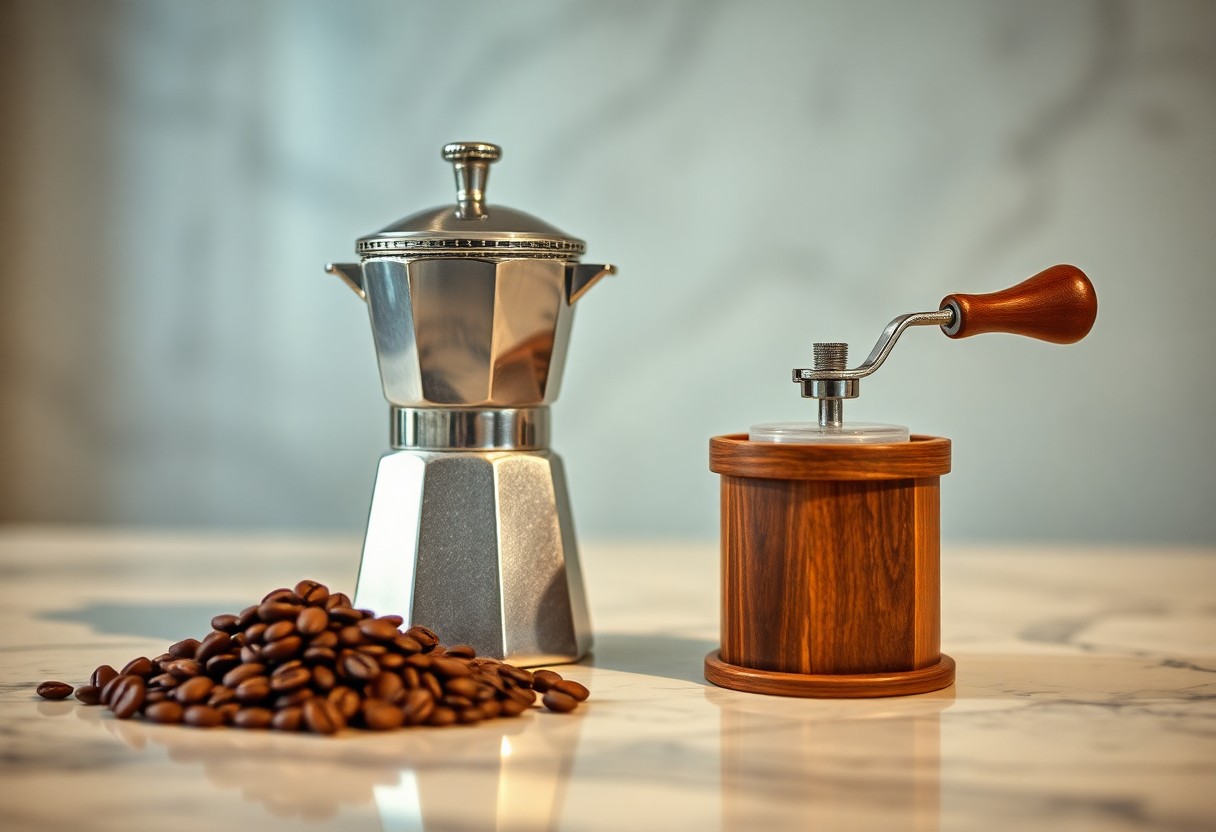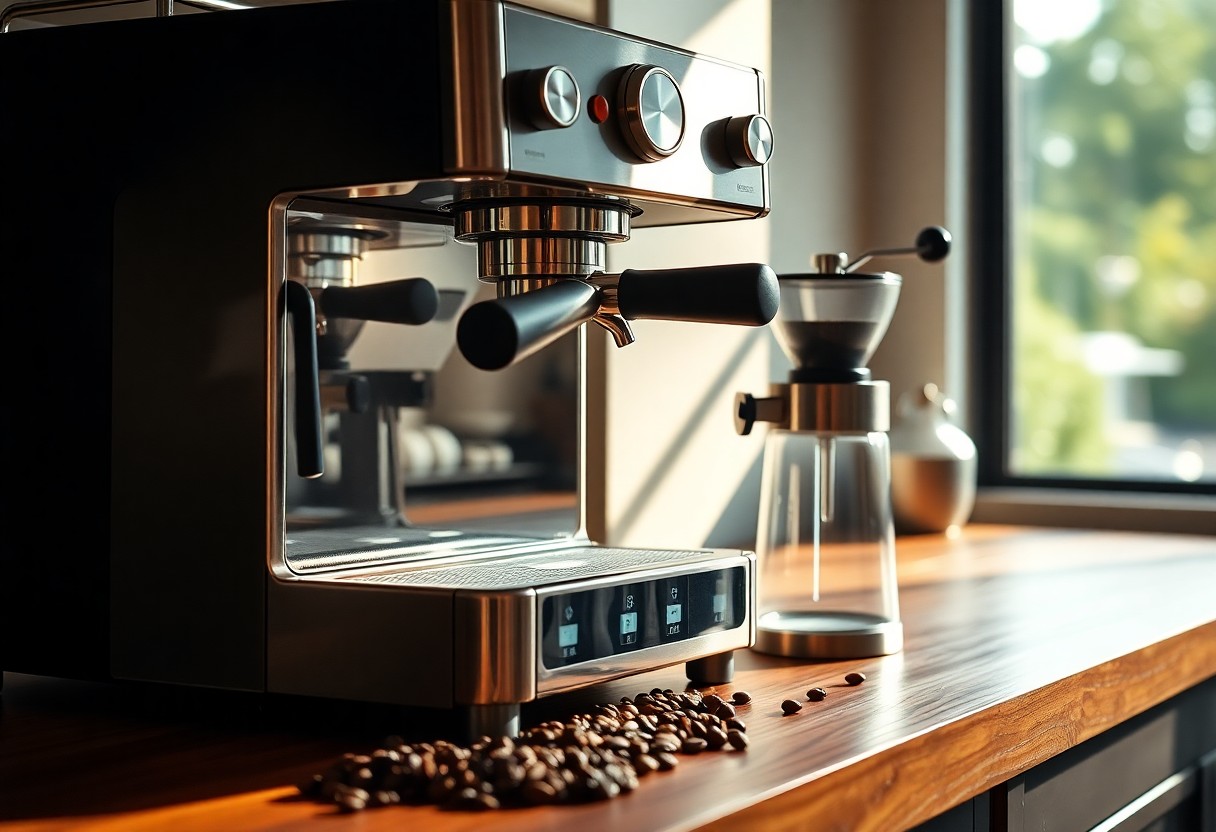Many coffee enthusiasts are turning to a minimalist approach to brewing espresso, simplifying the process to just two important tools. This streamlined method not only enhances your coffee experience but also reduces the clutter typically found in coffee setups. By focusing on quality and technique, you can achieve a rich and flavorful espresso without the fuss of complicated equipment. In this guide, you will discover how to make the most of your minimalist espresso journey and elevate your brewing skills to new heights.

Key Takeaways:
- Brewing minimalist espresso requires only a few vital tools, simplifying the process and making it more accessible for home enthusiasts.
- The right technique and quality of ingredients play a significant role in achieving a rich and flavorful espresso, even with limited equipment.
- Focusing on the basics allows for experimentation and personal adjustment, leading to a deeper appreciation of espresso craftsmanship.
The Essence of Minimalism in Coffee Brewing
Defining a Minimalist Approach
The minimalist approach to coffee brewing centers on the idea of stripping away excess tools and techniques, allowing you to connect deeply with the essence of the beverage. You focus on just the imperatives—the flavors and experiences within each brew, freeing yourself from distractions. Emphasizing quality over quantity, you can achieve gold-star results with only two tools, transforming your morning ritual into a mindful experience of simplicity.
The Philosophy behind Simplicity
This philosophy recognizes that less is often more, allowing you to appreciate the finer details of your coffee. By honing in on the brewing process with minimal distractions, you develop an intuitive understanding of how each element—from grind size to water temperature—contributes to the flavor profile of your espresso. You cultivate a deeper appreciation for your beans and become attuned to the nuances that emerge with each cup.
Adopting this outlook invites a form of creativity, prompting you to experiment and innovate without the burden of complicated equipment. You might find that maximizing flavor is achievable through a deliberate focus on technique and ingredient quality. Engaging with this philosophy opens a pathway to explore coffee in a way that promotes mindfulness, connection, and authenticity. Embracing simplicity not only enhances the brewing experience but also cultivates an appreciation for the artistry of espresso.

Key Tools for the Perfect Brew
To brew exceptional espresso, focus on two key tools that will elevate your coffee experience: a reliable espresso machine and a high-quality grinder. These tools form the backbone of your minimalist setup, ensuring you extract rich flavors while maintaining simplicity in your brewing process.
The Essential Espresso Machine
Your choice of espresso machine plays a significant role in the extraction process. Investing in a machine that offers consistent pressure and temperature control is vital for achieving that perfect shot of espresso. Look for one that has a built-in steam wand for frothing milk, adding versatility to your coffee repertoire.
The Indispensable Grinder
The grinder is arguably the heartbeat of your espresso setup, responsible for the texture and flavor of your brew. A burr grinder is preferable, as it provides uniform particle size, which plays a crucial role in the extraction process. Consistency leads to balanced flavors, ensuring a delightful drink every time.
When selecting a grinder, consider the grind settings it offers. A grinder with variable settings allows you to fine-tune your espresso grind, improving your chances of hitting the perfect extraction. For instance, a grind size of around 25 seconds can yield a balanced espresso shot, with a rich crema topping. A quality grinder not only enhances flavor but also ensures your morning ritual stays enjoyable and minimalistic.
Step-by-Step Guide to Brewing Espresso
| Step | Action |
|---|---|
| 1 | Measure out your coffee beans precisely for a balanced brew. |
| 2 | Grind the beans to a fine consistency, suitable for espresso. |
| 3 | Tamp the ground coffee evenly in the portafilter for uniform extraction. |
| 4 | Lock the portafilter into the espresso machine. |
| 5 | Start the brewing process and aim for a shot time of 25-30 seconds. |
| 6 | Serve immediately to enjoy the full flavor profile. |
Preparation: From Beans to Brew
Start your espresso journey by selecting high-quality beans that suit your taste preferences. Opt for a medium roast, which generally balances acidity and sweetness well. Using a scale, measure around 18-20 grams of coffee for a double shot. Grinding should be done just before brewing; aim for a fine consistency that resembles table salt to extract the best flavors without bitterness.
Brewing Techniques for Maximum Flavor
Focus on maintaining consistent temperature and pressure during the brewing process to extract the most flavor from your coffee. Water should be around 90-96°C (194-205°F) and brewed at approximately 9 bars of pressure. If your espresso machine has settings to adjust these, take advantage of them for a rich, full-bodied shot.
Experiment with your brewing variables for the best results. For instance, you might adjust the grind size or tamping pressure to see how it changes the flavor profile. Pay attention to the extraction time, ideally between 25-30 seconds, to avoid under or over-extraction. Under-extracted shots yield sour flavors, while over-extraction brings bitterness. Finding the sweet spot will ensure you’ll enjoy a robust, aromatic espresso every time.
Troubleshooting Common Espresso Issues
Even with the best tools, espresso can sometimes fall short of perfection. You might encounter issues with taste, extraction, or temperature, which can greatly affect your coffee experience. By understanding these common problems, you can tweak your brewing method or adjust your equipment for a more satisfying cup of espresso.
Identifying Common Brewing Problems
Espresso can taste bitter, sour, or dull due to various factors. If your shot pours too quickly or slowly, you could be facing issues with grind size, tamping pressure, or even the freshness of your coffee beans. Take a moment to evaluate your process and identify where you might be going wrong.
Solutions for the Perfect Cup
Refining your brewing technique is key to achieving that ideal espresso shot. Start by adjusting your grind; if your shot pulls too quickly, try a finer grind, as this increases resistance and slows down extraction. If it’s too slow, opt for a coarser grind. Tamping with consistent pressure of around 30 pounds can also make a difference in extraction quality. Lastly, ensure your machine is at the right temperature, ideally between 190°F and 205°F, to maximize flavor extraction.
Experiment with these adjustments and pay attention to the outcomes. For example, if using a finer grind yields a rich and balanced shot, make a note of it for future brews. Keep an eye on other elements like coffee freshness, as beans begin to lose their flavor after about two weeks. By constantly fine-tuning these aspects, you’ll perfect your espresso-making skills and enjoy a consistently delicious cup.
Elevating Your Minimalist Experience
Stripping down to the crucials doesn’t mean sacrificing quality. With just two tools, you can enhance your espresso-making journey by fine-tuning your technique and broadening your appreciation for flavor nuances. You’ll find that simplicity allows you to focus on the art of brewing, thus unlocking a more profound connection with each cup. The key lies in experimenting while maintaining a minimalist approach, ensuring that every sip is a celebration of the essence of espresso.
Expanding Your Flavor Palette
Exploring different beans, roast levels, and grind sizes can dramatically transform your espresso experience. Each coffee variety brings unique tasting notes, from fruity and floral to chocolatey and nutty. By trying out small-batch roasters or single-origin beans, you enhance your palette while retaining a minimalistic setup. Simple adjustments like timing and extraction method will highlight different flavors without overwhelming your brewing process or gear.
Incorporating Minimalist Accessories
Embracing minimalism doesn’t mean forgoing all accessories. Depending on your brewing method, a few thoughtfully chosen tools can enhance your espresso without adding clutter. A precise scale can help you dial in the perfect coffee-to-water ratio, while a simple timer ensures optimal extraction. Additionally, a high-quality tamper, lightweight and easy to store, can elevate your consistency in brewing better espresso.
Choosing minimalist accessories involves seeking out multi-functional items that serve several purposes, thereby maximizing efficiency without sacrificing quality. A minimal pour-over kettle, for instance, doubles as a brewing tool and a serving vessel. Opting for collapsible or stackable options also helps keep your coffee space tidy. Ultimately, these accessories should enrich your espresso-making ritual while harmonizing with your minimalist philosophy, ensuring that you have everything you need without excess.
To wrap up
With this in mind, embracing a minimalist approach to brewing espresso with just two tools can enhance your coffee experience while simplifying the process. You can achieve exceptional espresso by mastering the use of a quality grinder and an espresso machine or AeroPress. This streamlined method not only saves space and reduces clutter in your kitchen but also allows you to focus on honing your skills and appreciating the flavors of your brew. Enjoy the journey of espresso-making with less, and savor the rich rewards that come with simplicity.
FAQ
Q: What are the two tools needed for minimalist espresso brewing?
A: To brew espresso in a minimalist way, you only need an espresso machine (or an alternative espresso brewing device) and a coffee grinder. The espresso machine is responsible for brewing the coffee under pressure, while the grinder ensures that your coffee beans are freshly ground to the right consistency.
Q: Can I achieve the same flavor quality with just two tools?
A: Yes, you can achieve excellent flavor quality by focusing on the crucials. By using an espresso machine or its minimalist alternatives, combined with a high-quality grinder, you can control the brew process effectively. The key is to use fresh, quality coffee beans and to master the grind size and brew time to extract the best flavors.
Q: How important is coffee bean freshness in minimalist espresso brewing?
A: Freshness is paramount in espresso brewing, especially in a minimalist setup. Freshly roasted and ground coffee beans retain more flavor and aroma, significantly impacting the final cup. To ensure the best quality, purchase beans within two weeks of roasting and grind them just before brewing.
Q: What are the benefits of minimalism in espresso brewing?
A: The benefits of minimalism in espresso brewing include reduced complexity and cost, as fewer tools means lower financial investment. It also simplifies the brewing process, making it more approachable for beginners. Additionally, it encourages focus on technique, resulting in a more intentional and satisfying coffee experience.
Q: Are there any tips for achieving the perfect espresso shot with minimal tools?
A: To achieve the perfect espresso shot, ensure that you maintain the right grind size, which should be fine but not powdery. Precise measurement of coffee doses, ideally using a scale, is crucial for consistency. Lastly, monitor your water temperature and pressure settings if applicable, and practice your tamping technique to achieve an even extraction.
